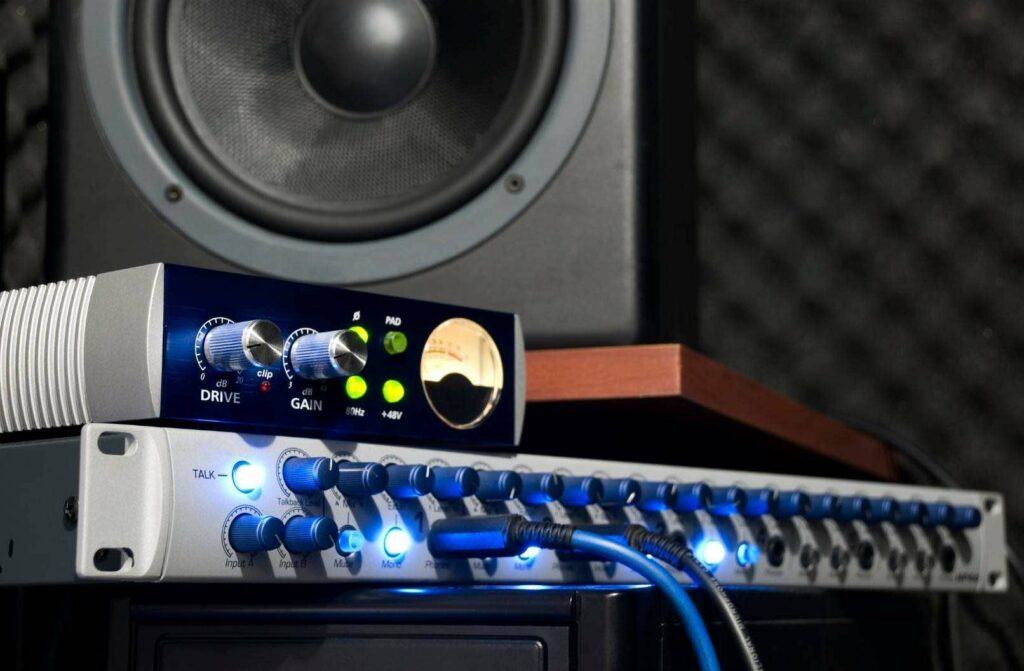
Audio interfaces are the heart of any recording studio. They’re the in-between device between from your computer to your microphones, instruments, speakers, headphones, and other audio gear. Without them you wouldn’t be able to record high-quality music, or route audio as you desire.
But is an audio interface a preamp? In this article answer your question, going into detail about what a preamp is, how it works, and the difference types.
Is an Audio Interface a Preamp?
Audio interface have in-built preamps. Without a preamp an audio interface wouldn’t be able to amplify weak signals -like those from a microphone or instrument- to the appropriate level for recording. Preamps come in two types, solid-state and valve. Both affect the sonic characteristics of an audio signal in different ways.
What is a Preamp?

Preamp stands for preamplifier. Its purpose is to amplify weak signals, making them louder so that they can brought up to the correct level. There are three types of levels used for recording.
Mic level (used for microphones) is the weakest, instrument level (used for instruments) is in the middle, and line level (used for audio gear like compressors, equalizers, effects units etc) is the hottest.
Mic level and instrument level both need to be amplified to line level. Otherwise, they are not powerful enough, or loud enough to be recorded. Without a preamp, an audio interface wouldn’t be able to do its job properly.
How Does a Preamp Work?

A preamp boosts an audio signal using an electrical current. Equally important, they have to do this whilst minimising raising the noise floor too much. In other words, they need to be able to turn up the audio signal, without turning up noise significantly.
In audio terms, we call this having a good signal-to-noise ration. How a preamp affects the sound of an audio signal depends on the type.
What Are the Types of Preamplifiers?

Preamps come in two forms, solid-state and valve, or tubes as their known in the US. Solid-state preamps sound cleaner and more transparent. They don’t really change the sound characteristics of the signal. In the audio world, we could say that they don’t colour the sound.
Valve amps on the other hand can sound warmer and more vibrant. They do colour the sound in a pleasing way, adding more flavour and character. Valve preamps -much like vale guitar amps- are more desirable for this reason.
It depends on the sound you’re looking for though. If you want a cleaner sound with no extra colour then a solid-state preamp is ideal. But for a more vintage, warm and colourful sound, you may want to use a valve preamp.
Don’t get too excited though. Valve preamps are commonly found on large mixing desks, which don’t come cheap! Unless, you have the budget to build a large professional recording studio, you’ll most likely be buying an audio interface.
Audio interfaces usually have solid-state preamps, but don’t let that put you off. Well-made ones still sound incredible, enabling you to record high-quality audio with precision and accuracy. But what if you still want that warm ‘vintage sound’?
Well, you’re covered. These days there are an abundance of plugins available that emulate and reproduce the sound of old analog gear. Do they sound good? Damn right they do. In fact, you’d probably struggle to hear difference between the plugins and the original gear.
Check out the video below, where Universal Audio shootout their own plugins between the actual gear they’re trying to replicate digitally. See if you can tell the difference.
Audio Interfaces Are Much More Than Just Preamps
An audio interface isn’t just a preamp, it has one in-built among many other physical components. All of which enable you to record, playback, and route high-quality audio. A preamp is one of the fundamental pieces of the puzzle so that weak quiet signals can be amplified to line level.
If you want to record music efficiently and accurately, then you’ll need to buy an audio interface from a reputable company. Audio interfaces work other magic too. Want to learn more? Check out my article ‘What is an Audio interface?’.
I hope this article answered your question and gave you a more thorough understanding of preamps. Please comment down below if you have any further questions.
Chris